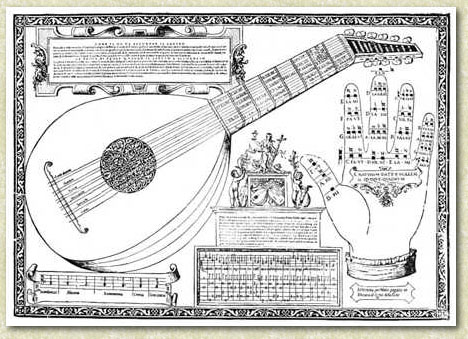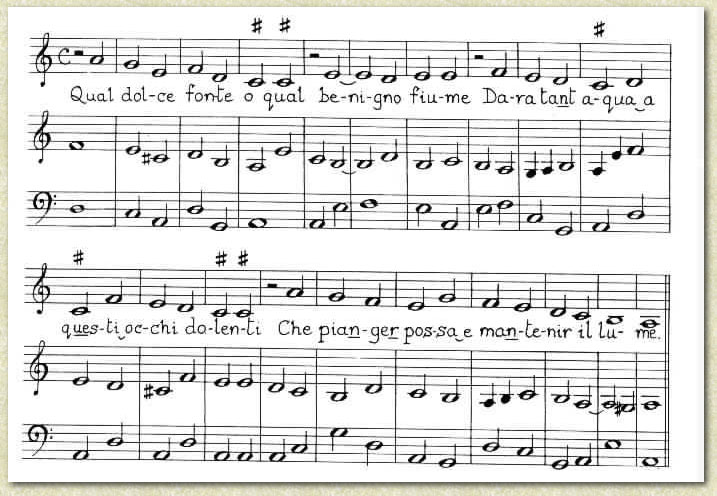An Unknown and Unique
Broadside Lute Instruction
By
Stockholm, Sweden 1987
 2009-12-01
2009-12-01
Kenneth Sparr's Page
When I was looking
for a copy of the famous Carrara broadside in the Royal Library, Stockholm, I
happened to come across another broadside which seems to be unique and unknown.(1)
I have not found references to it whatsoever. The broadside measures about 55 x
The Pagano
broadside is dominated by a cut of a six-course lute and a Guidonian hand. The
body of the lute is of a very rounded shape, and the woodcutter has worked
quite a lot to get a nice, ornamented rose. The neck has eight frets, obviously
double, and the number of pegs corresponds to the number of strings. From the
bass to the treble the courses are named Contrabasso, Bordon, Tenor,
Mezzanelle, Sotanelle and Canto. The text above the lute gives instructions on
how to tune the lute and how to check the tuning. The text below the instrument
provides information about tablature, rhythm-signs and right-hand fingering.

The Matteo Pagano broadside (Department of Maps and Engravings,
The Royal Library, Stockholm)
Finally there is a
song in mensural notation with a lute accompaniment in tablature. The text of
the song is as follows: 'Qual dolce fonte o qual benigno fiume Dara tãt' aqua a
q[ue]sti occhi dolenti Che piãger possa e mätenir il lume'. In the voice part
there are a number of mistakes: the minim rest in bar 5 looks wrong, as it
separates 'Oqual' from 'benigno'; having only one note for the two syllables of
'be-ni-' must also be incorrect; and the last note is surely not meant to be b.
The lute part consists of two voice-parts, and needs to be tuned to a
notational pitch of e' to match the voice. What appears to be semibreve rests
in the tablature must be number ones, and the minim rest in bar 1 of the
tablature is correct apart from being slightly misplaced. In bars 15 and 20
there are notes which are apparently placed on the wrong line, and so are a
fourth out. There is no known concordance to help.

Transcription of the music in
the Pagano broadside.
It is quite clear
from the instructions for tuning the lute (though not from the drawings of the
instrument) that the lowest three courses are to be tuned in octaves.
Throughout the instructions the 6th course (Contrabasso) has been mistaken for
the 5th course (Bordon), and vice versa. (This has been corrected in the
translation below.) We are told to begin by tuning the 1st course followed by
the 6th, thus providing a framework for tuning the other courses. The extensive
instructions for checking that the lute is in tune ensure not only that the
strings are in tune, but also that the frets are correctly placed. The checks
are to be made as follows:

How to check the tuning.
Here follows the
original Italian text on the broadside:
Come se da accordar il lavtto
Nota che a voler accordar il lauto, el bisogna considerar il cantom & secondo quello debbe fondar el bordon che li risponda in quintadecima. Et poi con il bordon accordar el contrabasso in quarta, cioe la corda grossa. Et poi la minore tirare alla ottava. Et cosi el tenor al predetto modo, con il contrabasso. Dapoi le mezzanelle, accordare con il tenor in terza, cioe con la corda grossa, & le sotanella [sic] con le mezzanelle in quarta. Et nota che le sottanelle & mezzanelle vanno vnisone, & le sottanelle con il canto in quarta. Di maniera che verra a esser come è detto di sopra in quintadecima con il bordone.
La prova di veder qvando il lavtto e accordato
La proua di veder se gliè ben accordato il Lautto, & che respõnda in tutte le parti e qlla prima che il bordõ e toccato nel secõdo tasto à piena rispõda cõ le mezzanelle in ottaua toccato à vodo. Et il medesimo tocato nel terzo, & le mezzanelle nel primo, rispõda ottaua. Similmente il cõtrabasso toccato nel secõdo tasto a pieno, & le sottanelle a vodo rispõda ottaua, & il medesimo toccato nel terzo & le sottanelle nel primo rispõda ottaua. Et similmente il contrabasso a vodo, 6 le mezzanelle al terzo tasto rispõda ottaua, & el medesimo le sottanelle al terzo a pieno & il tenor a vodo faccia ottaua. El tenor al secondo a pieno, & il cãto a vodo faccia ottaua. E il tenor al terzo, e il canto al primo faccia ottaua. E il canto al quinto tasto il contrabasso a vodo in quintadecima. Et le sottanelle al settimo, el le mezzanelle a vodo faccia ottaua. Il canto al settimo, e le sottanelle a vodo ottaua.
Nota che a voler intender la tabulatura del presente Lautto, Prima debbe saper che quelle sei righe doue sono quelle lettere d'abbaco rappresentano il manico Et secodo [sic] che tu vedi signato l'abaco cosi debbe toccare il Lauto, in quello tasto accompagnato o solo secondo che sono le lettere accompagnato o sole. Et letter O significa che tu debbi toccar quella corda a nodo [=vodo] [...](3) a quello tasto. Dapoi quelli rampini che tu vedi, significano la battitura, & la quantita delle botte. La virgula senza il rampino a questo modo [:]. ½significa vn tiempo cioe vna semibreue. E l'altro segno c~il rampino, significa mezo tempo & cosi di grado in grado, come q si vede. Et nota che il ponto che e posto sotto a qualche lettera significa che quella corda va toccata in su. E doue non e quel ponto va toccata in giu. Et questo ti basta virtuosos Giouane.
And in English
translation:
How to tune the lute
Note that if you want to tune the lute you need to start with the 1st course, to which you must tune the 6th course, so that they sound two octaves apart. And then tune the 5th course a fourth above the 6th course, that is above the thick string [of that course]. And then tighten the thin string an octave [higher], And similarly in the aforesaid manner tune the 4th course to the 5th course. Next tune the 3rd course a third [above] the 4th course, that is [above] the thick string, and [tune] the 2nd and 3rd courses a fourth apart. And note that the 2nd and 3rd courses are in unisons, and the 2nd and 1st courses are a fourth apart. In this way it will be seen, as mentioned above, that the 1st and 6th courses are two octaves apart.
The way to check if the lute is in tune
The way to check if the lute has been tuned well and if everywhere it sounds in tune with itself, is first to see that the 6th course stopped at the 2nd fret sounds an octave with the open 3rd course. And the same [course] stopped at the 3rd fret sounds an octave with the 3rd course stopped at the 1st fret. Similarly the 5th course stopped at the 2nd fret sounds an octave with the open 2nd course, and the same [course] stopped at the 3rd fret sounds an octave with the 2nd course at the first [fret]. And similarly the open 5th course and the 3rd course stopped at the 3rd fret sound an octave apart, and likewise the 2nd course stopped at the 3rd fret makes an octave with the open 4th course. The 4th course stopped at the 2nd fret makes an octave with the 1st course. And the 4th course at the 3rd fret makes an octave with the first course at the 1st fret. And the 1st course at the 5th fret and the open 5th course are two octaves apart. And the 2nd course at the 7th fret makes an octave with the open 3rd course. The 1st course at the 7th fret [makes] an octave with the open 2nd course.
Note that if you want to understand the tablature of the lute shown here, First you must know that those six lines, on which there are numbers, represent the fingerboard... [text unclear] And according to the numbers which you see indicated, you must finger the lute at one fret or more according to whether there is one or more number. And number 0 means that you must play that string open [..., see Note 3!] at that fret. Then those hooks which you see indicate the rhythm and the length of the notes. The stroke without a hook like this: means one beat, that is a semibreve, and the other sign with a hook means half a beat, and so on, step by step, as can be seen [below]. And note that the dot which is placed under some numbers means that that string is to be plucked upwards. And where there is no such dot, it is to be plucked downwards. And this is enough for you, virtuous young man.
The 'virtuous young
man' eager to play the music must indeed have been rather frustrated by the
Pagano broadside, with its mistakes in both the instructions and the
intabulation! Its interest now lies in its early dating and as a forerunner to
the much more developed broadsides by Michele Carrara from 1585 and 1594.
I wish to
acknowledge my debt to
The Pagano
broadside has been published in facsimile by The Lute Society. Contact the
Secretary of the society Christopher Goodwin
for further information.
This article has
been published in The Lute vol. XXVII (1987) pp. 30-34.
Notes
1. Both broadsides are kept in the
department of maps and engravings in the Royal Library, Stockholm. The Pagano
print has the shelf number Musikalier, Skåp 6c, Hylla 23. The broadside of
Michele Carrara, dated 1585, is listed in Howard Mayer Brown, Instrumental
Music Printed Before 1600 (Cambridge, Mass., 1965), p. 342, but the copy in
the Royal Library is not mentioned. This copy was observed by C. G. Stellan
Mörner in 'Rariteter ur en okatalogiserad notsamling i Kungl. biblioteket,
Stockholm', Svensk tidskrift för musikforskning 43 (1961), p. 273. Both
broadsides are also mentioned in my article. 'Lutan i Sverige - tiden
1520-1560', Svenska Gitarr- och Lutasällskapet [Journal of the Swedish
Guitar and Lute Society] (1986), part 1). pp. 32-33
3. There appears to be a line
missing here: '... and another number means you must stop it...'
Additions,
corrections are most welcome to
|
© |
|